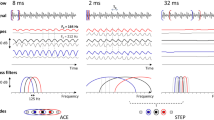Abstract
The objective of this study was to compare telephone speech perception and subjective preferences in cochlear implant users with two different speech-processing strategies: high-definition continuous interleaved sampling (HDCIS) and fine structure processing (FSP). A randomized double-blind study was designed for intra-individual comparison of HDCIS and FSP. Twenty-five post-lingually deafened patients with either the PulsarCI100 or SonataTI100 and Opus2 acoustic processor were tested consecutively with both coding strategies, assigned in a random order. Disyllabic word speech perception was tested 6 weeks after each fitting under the following conditions: landline use with (LWN) and without (LWoN) background noise, mobile use with (MWN), and without (MWoN) background noise and mobile use with a Bluetooth magnetic field transmitter necklace (MB). Changes in health-related quality of life (QoL) were assessed using the Glasgow Benefit Inventory (GBI) and Faber’s questionnaire. Personal preferences between strategies were surveyed upon completion of the study. All subjects included in this study performed better with FSP in the landline tests. There was an improvement of 11.5 % in LWN use (p = 0.014; CI 95 % = 3–20 %) and 10 % in LWoN use (p = 0.001; CI 95 % = 5–15 %). MWoN showed an improvement of 6.3 % with FSP (p = 0.03; CI 95 % = 0–13 %). MB tests showed an improvement of 11 % with FSP (p < 0.05; CI 95 % = 1.5–22 %). Quality of life was significantly better using FSP. Eighty-four percent of participants preferred FSP. The FSP speech coding strategy improved the speech recognition of cochlear implant users when using the telephone compared to HDCIS. Cochlear implantation with FSP coding improved QoL.

Similar content being viewed by others
References
Cohen NL, Waltzmann SB, Shapiro WH (1989) Telephone speech comprehension with use of the nucleus cochlear implant. Ann Otol Rhinol Laryngol Suppl 142:8–11
Adams JS, Hasenstab MS, Pippin GW, Sismanis A (2004) Telephone use and understanding in patients with cochlear implants. Ear Nose Throat J 83:96–103
Rodman J (2003) The effect of bandwidth on speech intelligibility. http://www.spectrum.com.sg/pdfs/The_Effect_of_Bandwidth_on_Speech_Intelligibility.pdf Accessed 22 July 2011
Brown M, Clark GM, Dowell RC, Martin FA, Seligman PM (1985) Telephone use and understanding in patients with cochlear implants. J Laryngol Otol 99:231–238
Castro A, Lassaletta A, Bastarrica M, Prim MP, de Sarria MJ, Gavilan J (2005) Speech discrimination through telephone in patients implanted with a Combi 40+. Acta Otorrinolaringol Esp 56(6):246–251
Kelsall DC, Shallop JK, Burnelli T (1995) Cochlear implantation in the elderly. Am J Otol 16:609–615
Facer GW, Peterson A, Brey AH, Marion M, Cevette M, Balki K, Green D, Rose D, Pool A (1994) The Mayo Clinic experience with the cochlear implant. Ear Nose Throat J 73:149–152 154–155
Ito J, Nakatake M, Jujita S (1999) Hearing ability by telephone of patients with cochlear implants. Otolaryngol Head Neck Surg 121:802–804
Wilson S, Finlay CC, Lawson DT, Wolford RD, Eddington DK, Rabinowitz WM (1991) Better speech recognition with cochlear implants. Nature 352:236–238
Pasanisi E, Bacciu A, Vincenti V, Guida M, Berghenti MT, Barbot A, Panu F, Bacciu S (2002) Comparison of speech perception benefits with SPEAK and ACE coding strategies in pediatric nucleus CI24 M cochlear implant recipients. Int J Pediatr Otorhinolaryngol 64:159–163
Hilbert C (1912) Grundzüge einer allgemeinen theorie der linearan integralgleichungen. Teubner, Leipzig
Vermiere K, Kleine Punte A, Van de Heyning P (2010) Better speech recognition in noise with the fine structure processing coding strategy. ORL J Otorhinolaryngol Relat Spec 72(6):305–311
Robinson K, Gatehouse S, Browning GG (1996) Measuring patient benefit from otorhinolaryngological surgery and therapy. Ann Otol Rhinol Laryngol 105:415–422
Faber E, Grontved AM (2000) Cochlear implantation and change in quality of life. Otolaryngol 543:151–153
Anderson I, Baumgartner WD, Böheim K, Nahler A, Arnolder C, D’Haese P (2006) Telephone use: what benefit do cochlear implant users receive? Int J Audiol 45(10):446–453
Riss D, Arnolder C, Baumgartner WD, Hamzavi JS (2008) A new fine structure coding strategy: speech perception at a reduced number of channels. Otol Neurotol 29:784–788
Arnolder C, Riss D, Brunner M, Durisin M, Baumgartner WD (2007) Speech and music perception with the new fine structure speech coding strategy: preliminary results. Acta Otolaryngol 127(12):1298–1303
Lorens A, Zgoda M, Obrycka A, Skarzynski H (2010) Fine structure processing improves speech perception as well as objective and subjective benefits in pediatric MED-EL COMBI 40 + users. Int J Pediatr Otohinolaryngol 74(12):1372–1378
Nopp P, Polak M (2010) From electric acoustic stimulation to improved sound coding in cochlear implants. Adv Otorhinolaryngol 67:88–95
Qian H, Louzou PC, Dorman MF (2003) A phone assistive device based on Bluetooth technology for cochlear implant users. IEEE Trans Neural Syst Rehabil Eng 11(3):282–287
Brill S, Müller R, Hagen R, Möltner A, Brockmeier S, Stark T (2011) Clinical trial results with the MED-EL fine structure processing coding strategy in experienced CIS users. Ear Hear (in submission)
Cohen SM, Labadie RF, Dietrich MS, Haynes DS (2004) Quality of life in hearing-impaired adults: the role of cochlear implants and hearing aids. Otolaryngol Head Neck Surg 131:413–422
Bichey BG, Hoversland JM, Wynne MK, Miyamoto RT (2002) Changes inn quality of life and the cost-utility associated with large vestibular aqueduct syndrome. Otol Neurotol 23:323–327
Francis W, Chee N, Yeagle J, Cheng A, Niparko JK (2002) Impact of cochlear implants on the functional health status of older adults. Laryngoscope 112:1482–1488
Lassaletta L, Castro C, Bastarrica M, Sarria MJ, Gavilan J (2006) Quality of life in postlingually deaf patients following cochlear implantation. Eur Arch Otorhinolaryngol 263:267–270
Cray W, Allen RL, Stuart A, Hudson S, Layman E, Givens GD (2004) An investigation of telephone use among cochlear implant recipients. Am J Audiol 13:200–212
Conflict of interest
The authors declare no conflicts of interest.
Author information
Authors and Affiliations
Corresponding author
Rights and permissions
About this article
Cite this article
Galindo, J., Lassaletta, L., Mora, R.P. et al. Fine structure processing improves telephone speech perception in cochlear implant users. Eur Arch Otorhinolaryngol 270, 1223–1229 (2013). https://doi.org/10.1007/s00405-012-2101-9
Received:
Accepted:
Published:
Issue Date:
DOI: https://doi.org/10.1007/s00405-012-2101-9




